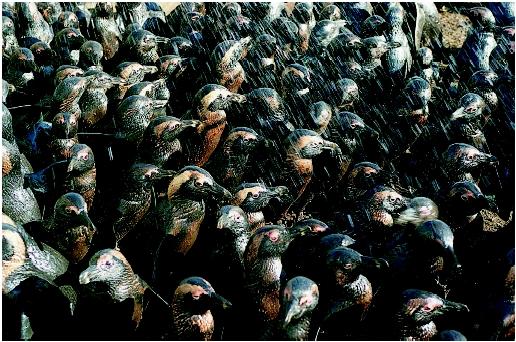The largest accidental oil spill on record (Persian Gulf, 1991) put 240 million gallons of oil into the ocean near Kuwait and Saudi Arabia when several tankers, port facilities, and storage tanks were destroyed during war operations. The blowout of the Ixtoc I exploratory well offshore Mexico in 1979, the second largest accidental oil spill, gushed 140 million gallons of oil into the Gulf of Mexico. By comparison, the wreck of the Exxon Valdez tanker in 1989 spilled 11 million gallons of oil into Prince William Sound offshore Alaska, and ranks fifty-third on the list of oil spills involving more than 10 million gallons.
The number of large spills (over 206,500 gallons) averaged 24.1 per year from 1970 to 1979, but decreased to 6.9 per year from 1990 through 2000.
The number of large spills (over 206,500 gallons) averaged 24.1 per year from 1970 to 1979, but decreased to 6.9 per year from 1990 through 2000.
Damage to Fisheries, Wildlife, and Recreation
Oil spills present the potential for enormous harm to deep ocean and coastal fishing and fisheries. The immediate effects of toxic and smothering oil waste may be mass mortality and contamination of fish and other food species, but long-term ecological effects may be worse. Oil waste poisons the sensitive marine and coastal organic substrate, interrupting the food chain on which fish and sea creatures depend, and on which their reproductive success is based. Commercial fishing enterprises may be affected permanently.Wildlife other than fish and sea creatures, including mammals, reptiles, amphibians, and birds that live in or near the ocean, are also poisoned by oil waste. The hazards for wildlife include toxic effects of exposure or ingestion, injuries such as smothering and deterioration of thermal insulation, and damage to their reproductive systems and behaviors. Long-term ecological effects that contaminate or destroy the marine organic substrate and thereby interrupt the food chain are also harmful to the wildlife, so species populations may change or disappear.
Coastal areas are usually thickly populated and attract many recreational activities and related facilities that have been developed for fishing, boating, snorkeling and scuba diving, swimming, nature parks and preserves, beaches, and other resident and tourist attractions. Oil waste that invades and pollutes these areas and negatively affects human activities can have devastating and long-term effects on the local economy and society. Property values for housing tend to decrease, regional business activity declines, and future investment is risky.
Long-term Fate of Oil on Shore
The fate of oil residues on shore depends on the spilled oil's composition and properties, the volume of oil that reaches the shore, the types of beach and coastal sediments and rocks contacted by the oil, the impact of the oil on sensitive habitats and wildlife, weather events, and seasonal and climatic conditions. Some oils evaporate, disperse, emulsify, weather, and decompose more easily than others. The weather and seasonal and climatic conditions may accelerate or delay these processes.
In 2000, several thousand penguins were affected by a fuel oil spill after the iron-ore carrier Treasure sank off South Africa. Many oil-soaked birds were cleaned and released.
Oil waste that coalesces into a tar-like substance or that saturates sediments above the surf and tide level is especially persistent. Efforts to remove the oil and clean, decontaminate, and remediate an oil-impacted shoreline may make the area more visibly attractive, but may be more harmful than helpful in terms of actual recovery.
Read more: Oil Spills: Impact on the Ocean - sea, effects, temperature, percentage, important, largest, types, source, marine, oxygen, human http://www.waterencyclopedia.com/Oc-Po/Oil-Spills-Impact-on-the-Ocean.html#ixzz1CS0MKVW1